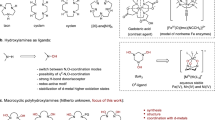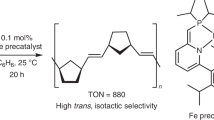Abstract
STABLE olefin complexes are formed only by metals near the end of each transition series in the Periodic Table, and these metals form a triangle in the Table, Cu(I) ; Pd(II), Ag(I) ; Pt(II), {Au(I) }, Hg(II). It is characteristic of the complex chemistry of metals inside the triangle that they tend to form stronger complexes with ligands containing donor atoms from the third or subsequent rows of the Periodic Table than with the corresponding ligands containing donor atoms from the second row (counting hydrogen and helium as the first row)1. This rule of co-ordination chemistry also extends to metals bordering on the ‘olefin-complex triangle’, especially to the metals to the left of the triangle. It seems reasonable to expect, therefore, that the triangle might eventually be extended to the left in the Periodic Table. With this object in view, we are attempting to obtain olefin complexes of cobalt, rhodium, iridium, iron, ruthenium and osmium, using the strongly chelating di-olefin, 1 : 5-cyclo-octadiene, and are now reporting briefly a series of rhodium complexes. When an ethanolic solution of rhodium chloride (RhCl3) to which 1 : 5-Cyclo-octadiene (C8H12) has been added is boiled under reflux, a very stable yellow crystalline solid of the composition C8H12RhCl is deposited. It is diamagnetic and dimeric, and so must have the chloro-bridged structure (I), in which the metal will have square planar (dsp2) co-ordination. When it is treated with an amine, am, the bridge is split to give mononuclear complexes of the type (II). Derivatives of (C8H12)2Rh2Cl2 (I) in which the chlorine atom is replaced by other univalent acid radicals, for example, bromine, iodine and SEt, were prepared. The stability of the derivatives falls rapidly in the order Cl > Br > I > SEt, as would be expected, since this is the order of increasing trans-effect of these acid radicals.
This is a preview of subscription content, access via your institution
Access options
Subscribe to this journal
Receive 51 print issues and online access
$199.00 per year
only $3.90 per issue
Buy this article
- Purchase on Springer Link
- Instant access to full article PDF
Prices may be subject to local taxes which are calculated during checkout
Similar content being viewed by others
References
See Leden and Chatt, J. Chem. Soc., 2936 (1955).
Fischer, E. O., scientific meeting of the Chemical Society, at Burlington House, London, Dec. 15, 1955.
Fischer and Hafner, Z. Naturforsch., 10 b, 140 (1955).
Cf. Chatt and Duncanson, J. Chem. Soc., 2939 (1953).
Author information
Authors and Affiliations
Rights and permissions
About this article
Cite this article
CHATT, J., VENANZI, L. Olefin Complexes of Rhodium. Nature 177, 852–853 (1956). https://doi.org/10.1038/177852b0
Issue Date:
DOI: https://doi.org/10.1038/177852b0
Comments
By submitting a comment you agree to abide by our Terms and Community Guidelines. If you find something abusive or that does not comply with our terms or guidelines please flag it as inappropriate.



